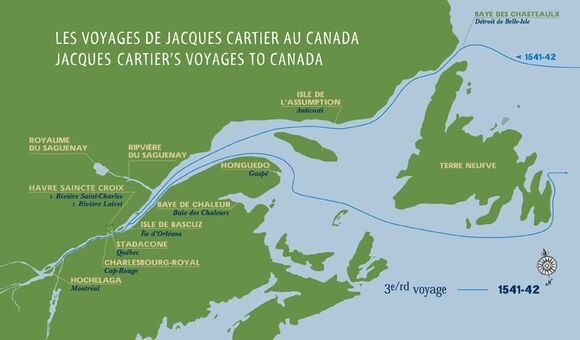In the 16th century, France’s King Francis I was interested in the new continent discovered by 15th century explorers, known today as America. He was interested in the land’s trading potential, particularly its natural resources, and the possibility of using it to find a new path to Asia. He therefore put Jacques Cartier in charge of a very important expedition, which was to set up bases for exploring and trading on the new continent.
In 1534, Cartier travelled with two ships paid for by France. When he arrived in the Gaspé region, he met Iroquoians from the Stadacona village, known today as Quebec City. The friendship he formed with them led to exchanges. Cartier then formerly claimed the Gaspé region in France’s name by erecting a cross. Donnacona, the Iroquoian chief, was against it, but Cartier convinced him by saying the cross was a simple landmark—which wasn’t true. After spending many weeks exploring, the navigator left for France together with Donnacona’s two sons which he took as hostages in exchange for not stealing other inhabitants.

The route of Jacques Cartier’s first voyage
In 1535, Cartier sailed to Canada with three boats. With help from Donnacona’s sons, who served as guides and interpreters, he reached Stadacona, known today as Quebec City, and dropped the two men off. Cartier then moved down the river to Hochelaga, known today as Montreal, despite Donnacona’s protests. A few weeks later, while passing through Stadacona once again, strong tensions divided the villagers and the expedition members. Before leaving, Cartier captured 10 Iroquoians, including Donnacona and his sons, to bring to the king. During this second voyage, Cartier and his team spent their first winter in North America and overcame scurvy with help from Stadacona’s people.

The route of Jacques Cartier’s second voyage
In 1541, Cartier was under the command of Jean-François de la Roque de Roberval, whom the king named “lieutenant general of Canada.” He spearheaded a first settlement project for a longer-term settlement on the land as well as the evangelization of the First Nations people.
Cartier led the first expedition group, while Roberval left a year later with the second. Cartier decided to set up the colony named Charlesbourg-Royal, on a cliff at the mouth of the Cap-Rouge river, not far from Stadacona. The relationship with the Iroquoians deteriorated as it became evident that the 10 people captured during the previous trip would not be coming back. The Iroquoians attacked the walled colony and killed 35 people. In the end, Cartier left with all his men and quickly returned to France with minerals he falsely believed to be gold and diamonds.

The route of Jacques Cartier’s third voyage
Roberval ran into Cartier en route near Newfoundland, and ordered him to go back, but Cartier disobeyed him by sailing to France in the middle of the night. Now alone with his men, Roberval took possession of the walled colony left by the first group and renamed it France-Roy. Over the winter, many of the 250 settlers that travelled with him died from scurvy. As a result, Roberval left, with the French’s first colonization attempt deemed a failure.
The first colonization attempt was a source of great disappointment. The settlement was unsuccessful, relationships with the Indigenous peoples were strained, and Cartier’s minerals—iron and quartz—turned out to be worthless.
Almost 50 years later, towards the end of the 16th century, the value of fur grew in Europe and the prestige of colonial powers drove the King of France, Henry IV, to make new attempts to colonize the American east coast.
The king offered different merchant companies the monopoly on the fur trade in New France or in one of its regions. It was an interesting idea for those who wanted to make money, because a single company would control the use and sale of fur. In exchange, the company had to finance the settlement of a community on the land. Put simply, merchants could use the land as a trading post settlement, but in return, they had to pay to establish a colony.
However, colonization was an arduous task for settlers. Despite the companies’ efforts, the settlements established were more trading posts than settlement colonies.
| Year | Place | Settlement Type | Person Responsible | Conditions | Results |
| 1598 | Sable Island (south of Nova Scotia) |
Trading post | Troilus de La Roche de Mesgouez (merchant) | Settlers colonized the land in exchange for the monopoly of the fur trade | Failed due to a lack of resources. |
| 1600 | Tadoussac (north shore of the St. Lawrence River) |
Trading post | Pierre de Chauvin de Tonnetuit (merchant) | Failed due to the climate. Became a trading post used every summer |
|
| 1604 | Île de Sainte- Croix (in Acadia) | Trading post | Pierre Dugua de Mons (merchant) | Failed due to the climate. | |
| 1605 | Port-Royal (north coast of Nova Scotia) |
Trading post | Pierre Dugua de Mons and Samuel de Champlain (merchants) | Settlement succeeded: Project was stopped because it was too expensive |
From 1605, the Port-Royal colonial settlement, under De Mons, operated relatively well. More people survived the winter and scurvy thanks to the farm animals reared in France, vegetable reserves and an excellent relationship with the Indigenous peoples. Nevertheless, the king revoked De Mons’ fur trade monopoly in New France, which affected his earnings. In turn, De Mons refused to finance the colony, which he left in 1607.